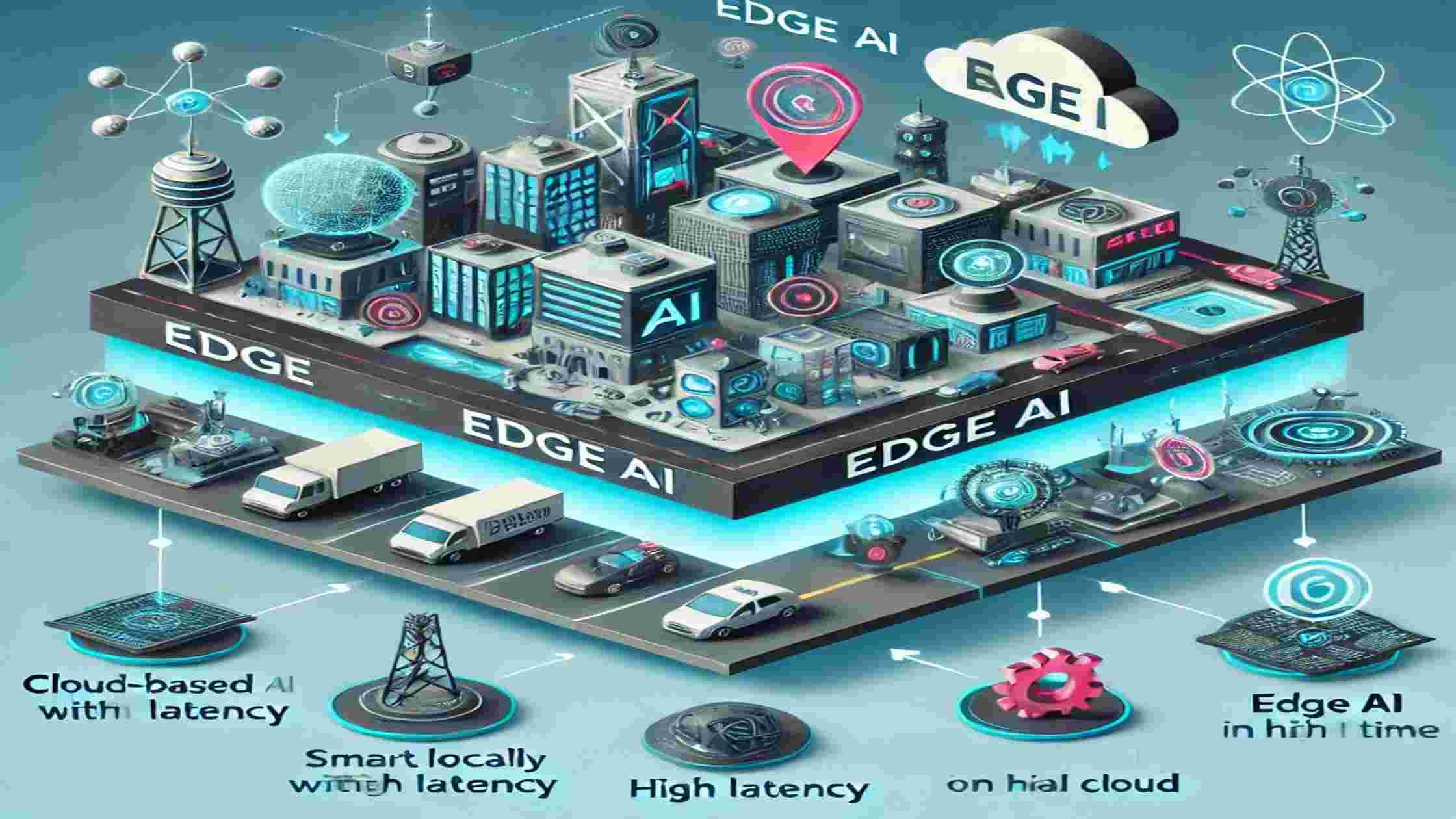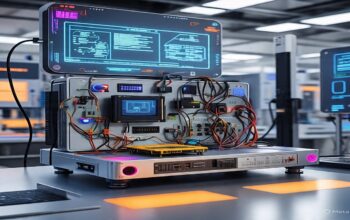Artificial intelligence (AI) has rapidly changed over the last ten years and is now a significant component of many different sectors. AI has demonstrated its potential in a variety of domains, including transportation and medicine. However, the need for quicker, more effective AI solutions has increased as more devices connect to the internet, which is how Edge AI was created.
We’ll go over what Edge AI is, how it operates, and its numerous uses in a variety of sectors in this blog post. You will know more about this innovative technology and how it is changing the digital landscape at the end of this article.
Covered Contents
ToggleWhat Is Edge AI?
Edge AI is the process of executing artificial intelligence calculations locally on a device, commonly known as the “edge” of the network, as opposed to the exclusive use of cloud-based AI. Traditionally, high-performance cloud servers are used to process data and run AI models. However, Edge AI enables faster decision-making by processing data locally on the device or nearby local systems.
By significantly reducing the volume of data that must be sent back and forth to cloud servers, this technique improves privacy, reduces latency, and uses less bandwidth. Stated differently, Edge AI allows devices to make intelligent decisions on their own, in real time, and with minimal reliance on cloud processing.
Types of Edge AI:
There are typically five primary types of Edge AI, although the exact categories may differ depending on the implementation and use case. They include:
–Device-based Edge AI
-Gateway-based Edge AI
-Fog Computing
-Cloud-Edge Hybrid AI
-Edge AI with 5G
Each of these types is used for different purposes, from local device processing to a more integrated system with cloud systems or high-level networking.
Device-based Edge AI
This category entails running AI algorithms on the edge device itself, e.g., smartphones, smart cameras, or wearables. The devices gather and process data locally, allowing for real-time action without cloud processing. It’s perfect for scenarios demanding rapid decision-making, e.g., facial recognition or health monitoring.
Gateway-based Edge AI
In gateway-edge Edge AI, local gateway hardware performs the data processing, possibly positioning itself between the cloud and the edge devices. Such gateways consolidate information from numerous edge devices, perform initial analysis, and pass processed insights on to the cloud. It’s implemented in IoT networks where coordination across several sensors or devices is necessary.
Fog Computing
Fog computing takes cloud computing to the network edge, where data is processed nearer to the source. This is a form of Edge AI that comprises distributed data processing on multiple nodes between the edge devices and cloud servers. It’s applied in industrial use, where there is a need for real-time processing but cloud connectivity is slow or minimal.
Cloud-Edge Hybrid AI
This is a hybrid of Edge AI and cloud computing. The edge handles some of the data, with heavier tasks or bigger data sets being transferred to the cloud for analysis. It finds a balance between low-latency, real-time decision-making on the edge and the massive computational capabilities of cloud-based AI, typically utilized in large systems such as autonomous cars.
Edge AI with 5G
This form of Edge AI takes advantage of the high-speed and low-latency features of 5G networks to increase the efficiency of Edge AI systems. It allows for the accelerated processing of data at the edge and faster device-to-device communication, enhancing applications such as autonomous vehicles, smart cities, and real-time industrial control.
Read More: How 5G Will Transform Your Life by 2025
How Does Edge AI Work?
To understand how Edge AI works, let’s break it down into simple steps. Here’s the general workflow of an Edge AI system:
Data Collection
Edge devices such as smartphones, cameras, sensors, and wearables initially gather data from the surroundings. For instance, a smart camera may record video, while a fitness tracker gathers heart rate information.
Local Processing
After the data is collected, it gets processed on the device or a local gateway. Pre-trained AI models on edge devices run the data analysis and processing. The models can include performing tasks like detecting objects, facial recognition, or predicting trends based on sensor input.
Decision Making
Once the data has been processed, the device will make a prediction or decision depending on the analysis of the AI model. A smart thermostat could change room temperature according to the behavior patterns of an individual, or a security camera could identify a person’s face and notify them.
Action and Feedback
Depending on the decision or forecast, the device acts independently or provides feedback to the cloud or other linked systems. Nevertheless, only the necessary, processed information is forwarded to the cloud, conserving bandwidth and guaranteeing that useful insights are passed on.
Continuous Learning (Optional)
Other Edge AI solutions also possess the ability to learn and get better with time. With the accumulation of more data and improvement of its models locally, the system gets smarter without frequent cloud updates.
Why is Edge AI Important?
Edge AI solves some of the challenges and provides multiple benefits that can’t be matched by conventional cloud-based AI systems. Let‘s consider why Edge AI is so important:
Low Latency
One of the most significant advantages of Edge AI is lower latency. In cloud AI, data must travel from the device to a server, get processed, and then be sent back. This lag can be crucial in real-time applications such as autonomous driving or health monitoring. Edge AI enables real-time decision-making, as the data gets processed locally without any delay.
Minimized Bandwidth Utilization
It is costly and inefficient to send data to the cloud to be processed, particularly for devices that produce vast amounts of data, such as video cameras or IoT sensors. Edge AI lessens the data that must be transmitted since only processed information or insights are sent to the cloud, thereby conserving bandwidth and expense.
Improved Privacy and Security
Privacy is an increasingly important issue in the data-oriented world of today. Edge AI provides improved privacy since it enables sensitive information to remain on the device instead of being transmitted to a central server. For instance, facial recognition on a phone can be performed locally, making it less likely for data breaches to occur.
Offline Operation
Several Edge AI systems can operate without ongoing internet connectivity. For example, a wearable technology can still record health information and make decisions regardless of whether or not it has cloud connectivity at the time. This makes Edge AI particularly useful in low- or remote-connectivity situations.
Scalability and Cost-Efficiency
Edge AI systems are generally less expensive to run in mass deployments since they don‘t need continuous cloud communication. They also minimize the use of costly cloud infrastructure, which simplifies scaling and handling large networks of devices.
Applications of Edge AI
Edge AI is utilized across industries to enhance efficiency, facilitate real-time decision-making, and deliver smart services. Some of the most prevalent uses of Edge AI are listed below:
Self-driving vehicles:
Self-driving cars are greatly dependent on AI for navigation, object recognition, and decision-making, processing camera, radar, and LiDAR sensor data. Edge AI enables these cars to process data locally, making them capable of real-time driving decisions and respond immediately to their surroundings. This is important for safety, as any delay in cloud processing would result in accidents. For instance, when a car notices an obstruction on the road, it needs to react quickly. Using Edge AI, the vehicle can identify the obstruction and react within milliseconds without going through cloud communication.
Read More: Edge computing: Role in autonomous vehicles
Healthcare
In medicine, Edge AI is assisting doctors and medical staff in delivering improved, accelerated care by making real-time monitoring and analysis possible. Wearables such as smartwatches monitor heart rate, sleep, and physical activity and notify users of possible health concerns in real time. Edge AI also enables medical devices to perform patient data locally. For instance, AI-equipped ultrasound devices can examine images in real time and give doctors immediate feedback without having to upload images to a cloud server, thereby accelerating diagnostics and enhancing patient care.
Read More: 10 Must-Have Wearable IoT Devices for 2025
Manufacturing and Industry 4.0
Edge AI is also key in the manufacturing industry for predictive maintenance and quality control in real-time. Machinery sensors can monitor for wear and tear, signs of malfunction, and process such data locally to forecast when a machine will fail. By deciding at the edge, businesses can bypass expensive downtime and prevent equipment failures before they happen. For instance, if a sensor detects a flaw in a product being made in the production line, it can halt the line to correct it, thereby ensuring that faulty products are not produced. This minimizes downtime, maximizes product quality, and, in the long term, saves companies money.
Retail
Retailers are using Edge AI to enhance customer experiences and improve store operations. Smart cameras track customer movements and interactions with products, providing valuable insights into shopping behavior. This data helps optimize store layouts, improve product placement, and offer personalized promotions to customers. Additionally, Edge AI plays a key role in inventory management. Smart shelves can detect when items are running low and automatically reorder stock, improving efficiency, reducing human error, and ensuring shelves are always stocked.
Smart Cities
Edge AI is a foundational technology for building smart cities. Real-time data about traffic, energy usage, and pollution are collected through sensors that are embedded in roads, buildings, and infrastructure. Edge AI runs the data locally, facilitating fast decision-making and optimizing city operations.
For instance, edge AI is used by traffic management systems to control traffic flow and optimize signal times in real-time, easing traffic congestion and streamlining traffic efficiency.
READ More: Edge Computing in Smart Cities
Agriculture
Agriculture also benefits from Edge AI, as farmers can monitor crops and livestock more easily. AI-powered farming drones and camera-equipped sensors can scan plant health, detect pests, and even water usage. Real-time detection of issues like warning of disease at an early stage or outbreak of pests is facilitated by Edge AI, which allows the farmer to respond rapidly, i.e., treat where the pesticide is needed, saving resources and increasing yields. Further, AI systems can also optimize irrigation based on real-time weather and soil conditions, saving water resources while giving the crops the right amount of water.
Smart Homes:
Smart home devices such as security cameras, smart speakers, and smart thermostats are using Edge AI to enhance their performance and responsiveness by taking decisions in real-time. For instance, AI-enabled security cameras process video on premises, identifying suspicious activity and alerting homeowners right away without uploading all video to the cloud. Similarly, smart thermostats use Edge AI to learn home temperature habits and regulate the climate automatically based on patterns, enhancing comfort while saving energy. Smart thermostats are becoming smarter, faster, and more efficient with Edge AI, adding to overall home automation.
How Edge AI Differs from Cloud AI
Though both Edge AI and cloud AI are artificial intelligence, they differ in where the data is processed and how rapidly the results are returned.
Cloud AI:
Data in the cloud, AI is transmitted to high-capacity cloud servers that process and analyze the data. After processing the data, the output is transmitted back to the device. It takes time because of the requirement for data transfer that can lead to latency.
Edge AI:
Contrary to this, Edge AI executes data processing locally on the device or an adjacent gateway. This dramatically decreases latency and makes real-time decision-making possible without cloud communication wait time.
Feature | Cloud AI | Edge AI |
Data Processing | Done on cloud servers. | Done locally on the device. |
Latency | Higher due to data transfer. | Lower with real-time processing. |
Data Transfer | Requires sending large data. | Minimal data transfer. |
Internet Dependency | Needs a stable internet connection. | Can work offline or with limited internet. |
Speed | Slower results. | Faster, immediate results. |
The Future of Edge AI
The future is promising for Edge AI. With AI algorithms getting better in terms of efficiency and edge devices getting more powerful, we can expect to see more usage across various industries. With the incorporation of 5G technology, Edge AI capabilities will also be enhanced through faster and more stable communication, enabling even more real-time applications.
Edge AI is not a trend, it is the fundamental technology of the future. It makes devices more autonomous, efficient, and responsive. Self-driving cars, smart homes, or medicine, Edge AI will be the driving force to make the future of technology a reality.
Conclusion
Edge AI is revolutionizing how we engage with technology. With local processing of data at the edge device, Edge AI offers quicker, more secure, and streamlined AI-powered solutions. Autonomous vehicles, smart homes, and healthcare are all areas where Edge AI is already making a big difference.
With advancements in technology, we can look forward to Edge AI spreading across industries, enabling faster, intelligent, and more personalized experiences. The synergy of real-time processing, enhanced privacy, and cost savings makes Edge AI a compelling tool for the future.



4 thoughts on “What Is Edge AI? How It Works, Types, and Applications”